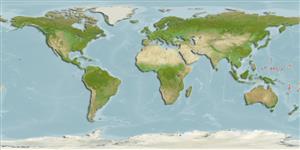Classification / Names
Populärnamn | synonymer | Catalog of Fishes(Släkte, Arter) | ITIS | CoL | WoRMS | Cloffa
>
Gobiiformes (Gobies) >
Xenisthmidae (Collared wrigglers)
Etymology: Paraxenisthmus: Greek, para in the side of + Gree, xenos = strange + Greek, isthmos = narrow passage (Ref. 45335); cerberusi: Named for Cerberus, the three-headed dog guarding the gates of Hades; refers to the relatively toothy attributes of the genus, and to the black juveniles and red and black adults, colors often associated with the darkness and flames of Hell..
More on authors: Winterbottom & Gill.
Environment: milieu / climate zone / depth range / distribution range
Ekologi
marina bottenlevande; djupintervall 12 - 26 m (Ref. 56733). Tropical
Western Central Pacific: Palau.
Size / Vikt / Age
Maturity: Lm ? range ? - ? cm
Max length : 2.1 cm SL hane/ej könsbestämd; (Ref. 56733); 2.1 cm SL (female)
Short description
Morfologi | Morfometri
Taggstrålar i ryggfenan (totalt): 7; Mjukstrålar i ryggfenan (totalt): 11; Taggstrålar i analfenan 1; Mjukstrålar i analfenan: 10. Diagnosis: Distinguished from its congeners in having 15-16 pectoral fin-rays (vs. 18); cephalic lateralis pore P absent (vs. present); head, nape, ventral abdomen, and dorsal midline of caudal peduncle naked (vs. scaled); and caudal peduncle with a large, black blotch (vs. none) (Ref. 56733).
Small, sand-diving gobioids; inhabits drop-off with caves and ledges, silty sandy shelves and slopes, with hydroids, sea fans and a variety of hard corals and some Halimeda (Ref. 56733).
Life cycle and mating behavior
Könsmognad | Reproduktion | Lek | Ägg | Fecundity | Larver
Winterbottom, R. and A. Gill, 2006. Paraxenisthmus cerberusi, a new species of xenisthmid fish from Palau (Percomorpha: Gobioidei). Copeia 2006(1):10-13. (Ref. 56733)
IUCN Red List Status (Ref. 130435)
Threat to humans
Harmless
Human uses
Ytterligare information
PopulärnamnsynonymerMetabolikPredatorerEkotoxikologiReproduktionKönsmognadLekSpawning aggregationFecundityÄggEgg development
Age/SizeTillväxtLength-weightLength-lengthLength-frequenciesMorfometriMorfologiLarverLarvdynamikRekryteringAbundansBRUVS
referenserVattenbrukVattenbruksprofilAvelslinjerGenetikElectrophoresesÄrftlighetSjukdomarBehandlingNutrientsMass conversion
MedarbetareBilderStamps, Coins Misc.LjudCiguateraHastighetSimsättGälytaOtolithsHjärnstorlekSyn
Verktyg
Special reports
Download XML
Internet-källor
Estimates based on models
Preferred temperature (Ref.
123201): 27.2 - 29.1, mean 28 °C (based on 22 cells).
Phylogenetic diversity index (Ref.
82804): PD
50 = 0.7500 [Uniqueness, from 0.5 = low to 2.0 = high].
Bayesian length-weight: a=0.00389 (0.00180 - 0.00842), b=3.12 (2.94 - 3.30), in cm total length, based on all LWR estimates for this body shape (Ref.
93245).
Trofisk nivå (Ref.
69278): 3.1 ±0.4 se; based on size and trophs of closest relatives
Fishing Vulnerability (Ref.
59153): Low vulnerability (10 of 100).
